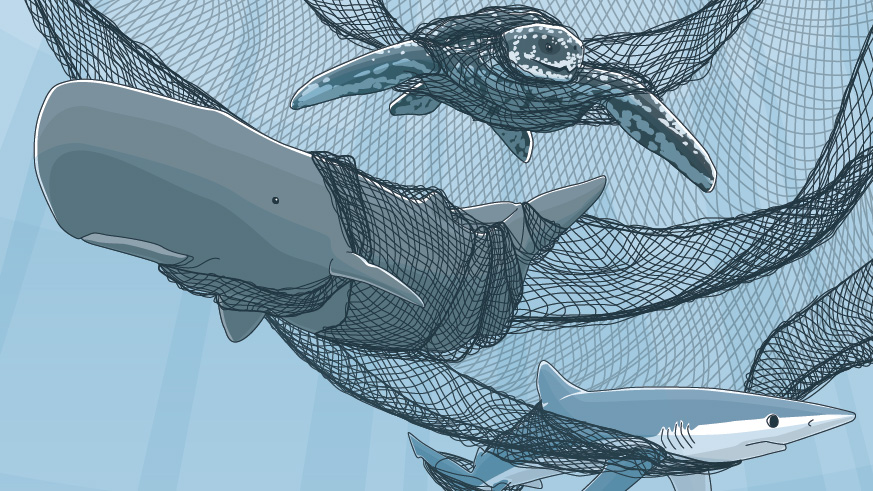Good News for Those Who Love Eating Swordfish and Want Whales Protected
For years, the drift gillnet fishery off the coast of California has been wrought with controversy. This form of fishing is notoriously indiscriminate in the way that it catches, and often kills, iconic marine mammals and turtles that help make the Pacific Ocean a special place.
In a visionary move this week, the Pacific Fishery Management Council (PFMC) unanimously agreed that it’s time to transform the way this fishery will be managed. Almost 6,000 people sent messages to the PFMC asking for change, and the council responded by agreeing on the need to establish enforceable limits on the death and discard of several species of marine life caught incidentally by drift gillnets.
 Illustration: Ned Drummond
Illustration: Ned DrummondDrift gillnets target swordfish but indiscriminately kill other animals, too, including many species of game fish, sharks, marine mammals, and Pacific leatherback sea turtles.
Drift gillnets can be as long as 6,000 feet, reach 200 feet below the surface, and are typically submerged for hours at a time. Not surprisingly in a marine ecosystem as diverse as the California Current, the nets too often entangle whales, turtles, dolphins, and sharks while intending to catch swordfish.
The council cited unacceptable levels of bycatch—or the unintentional catch of non-targeted species that is discarded, often dead— for why it needs to establish firm limits on the damage inflicted by drift gillnets. Once bycatch limits are reached, all fishing would be shut down for the season to prevent additional harm to non-targeted ocean wildlife.
To enforce the new limits, the council announced its intent to require 100 percent accountability through either human observer coverage or electronic monitoring so that all catch and bycatch is counted on every trip no later than late summer 2016. Such a requirement, if ultimately adopted by the National Marine Fisheries Service, represents a substantial increase from the scant 20 percent observer coverage accorded this fishing until 2013, when the agency imposed and later extended a temporary emergency rule to protect sperm whales in deep water.
While this week’s action is good news, there is more to do. Ultimately, this fishery needs to transition to alternative gear types that are cleaner than drift gillnets, and we are encouraging the council to follow through on the commitment it made in March to shift the California swordfish fishery to “more environmentally and economically sustainable” alternative fishing methods. To that end, the council on Monday also approved a process for issuing experimental fishing permits to fishermen willing to try alternatives, such as deep-set buoy gear.
I love the taste of swordfish, especially knowing it was caught by an American fisherman. But my appetite wanes when I realize it potentially comes at the expense of killing endangered marine mammals.
It’s time to find a way for swordfish fishermen to catch these fish while leaving other marine life in the water where it belongs.
Paul Shively manages ocean conservation efforts for The Pew Charitable Trusts along the West Coast.






